We saw lots of Hoopoes during our two week expedition to Menorca. Hang on, let me rephrase that a little. We heard many a Hoopoe; probably several dozen. We saw less - five or six individuals on a typical day.
"Click the pics" to see Hoopoe action.
"Click the pics" to see Hoopoe action.
The Hoopoe’s “oop,oop,oop,oop” call carries many a mile over the quiet landscape of Menorca. But this mainly shy bird often calls from the cover of a copse, a dry stone wall or the corner of a distant building. For an apparently highly visible bird with a funky hairdo the Hoopoe can be difficult to spot. Its striking but basically sandy-brown plumage blends well with the dry landscape while the black & white wing pattern and the bird’s erratic butterfly flight allows the bird to dissolve into the dappled light of a Menorca day.
The Hoopoe is very common in Menorca where it occupies a wide variety of habitats: vineyards, gardens, parks, woodland and agricultural situations. In fact anywhere that will hold a dark cavity in which they can raise a family.
The stink from a Hoopoe nest is legendary. The female secretes a substance of foul odour from the uropygial gland. This liquid smells like rotten meat. Due to the unpleasant smell, most predators stay away from the nest. On the other hand, insects, the Hoopoe's food, will be attracted but may find themselves to be the next Hoopoe meal.
I didn’t test out the smelly nest theory when I found a nesting pair during the first week of our holiday as it was a hands and knees job. The nest site was an inch or two from the ground with the danger of rubbing my nose into soil and debris from the unkempt surroundings.
Initially I thought that the adults were feeding only tiny young as they carried quite small morsels of food into the lump of pre-cast concrete with a handy cavity. Mostly the adults took items through the hole and left quickly, but on occasions the slightly smaller female stayed in to brood the chick(s). One food item seemed to be favoured, a small, red spherical creature that appeared to be a spider or bug. On other occasions it was definitely spiders of one sort or another.
May 18th was our flight home day. So on the late afternoon of the 17th I left Sue packing and drove for a last look and check of the Hoopoe’s nest. I was glad I did because after a while and soon after the female departed the nest, a younger head appeared at the hole.
The youngster peered out into the world it would soon inhabit. Passing cars, footsteps, sounds of laughter & joy from a nearby villa and swimming pool. The click of a camera from the window of a Fiat Panda didn't phase the youngster as it waited patiently for mum to return.
Hoopoe chick
Wow. That’s some gape; pure white, unmissable in the darkened depths of a nest when the adult arrives with a pile of grubs to share. Maybe there was only one youngster after all? We'll never know but my guess would be that the young Hoopoe was big enough to fly away on 18th May at much the same time as we flew back to Manchester Airport.
In the UK the Hoopoe is uncommon enough to be an attraction for twitchers. I guess it’s those jazzy looks, the wish to see that slow fanning in and out of the headdress or to hear that mellow “oop, oop, oop”?
Bird ringers will testify that in the hand the Hoopoe is something of a disappointment. Beneath that colourful finery lays a rather scrawny skeleton that seems in desperate need of a good meal. But I must admit a Hoopoe does make for a nice ringing “tick” and a good enough photograph.
Linking today to Anni's Blog and World Bird Wednesday.
Linking today to Anni's Blog and World Bird Wednesday.







































































































